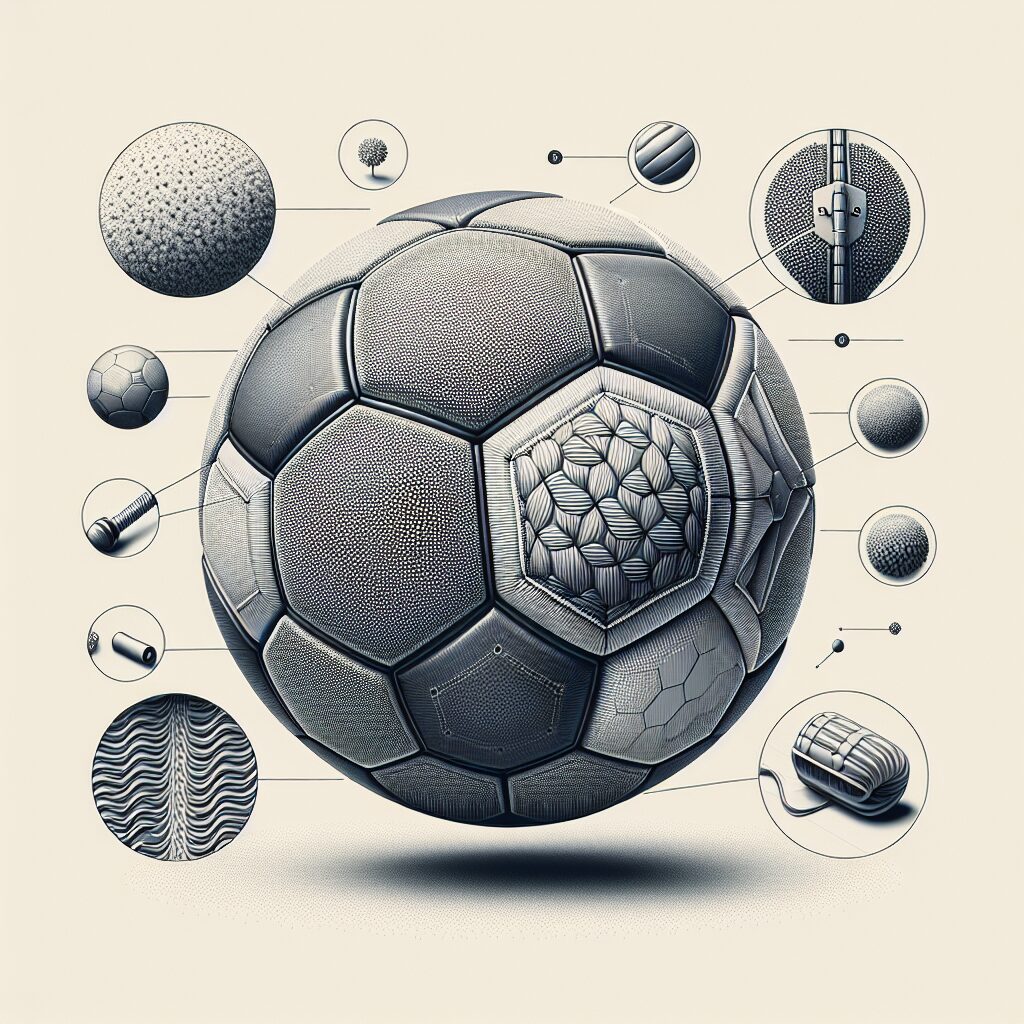Soccer, also known as football in many parts of the world, is a sport treasured by millions, if not billions, of people worldwide. The game is simple yet captivating, with its main equipment, the soccer ball, playing a crucial role in every match. Curiously enough, have you ever wondered what makes soccer balls? The answer lies in the materials used to construct these spherical objects of play. Understanding the different materials that make up soccer balls can provide valuable insights into their unique features and impacts on the game. In this article, we will delve into the fascinating world of soccer ball materials, exploring their composition, characteristics, and the important role they play in the game.
One of the key materials used for soccer balls is synthetic leather, commonly known as polyurethane (PU). PU offers numerous advantages, including durability, water-resistance, and excellent aerodynamics. These characteristics make it ideal for high-quality match balls, ensuring they can withstand rigorous use and maintain their shape even in adverse weather conditions. Additionally, PU enhances the ball’s aerodynamics, allowing it to fly smoothly through the air and accurately respond to players’ strikes. Another significant material used in soccer balls is natural leather. Although less common nowadays due to its high cost and limited availability, natural leather provides exceptional softness and control. Players who prefer a more traditional touch often opt for soccer balls made with genuine leather, appreciating the unique feel and responsiveness it offers on the field.
In the upcoming sections, we will discuss the various materials used in soccer ball construction in greater detail. From the inner bladder to the outer cover, we will explore the impact each component has on the ball’s performance. Furthermore, we will examine how these materials influence not only the game but also the players’ experience and the overall development of the sport. Stay tuned as we unravel the secrets behind the materials that make soccer balls and revolutionize the world of football.
Key Takeaways
1. Soccer balls are made up of several layers of materials, including an outer cover, a lining, and a bladder. The outer cover is typically made of synthetic leather or PVC, providing durability and water resistance. The lining, made of cotton or polyester, adds strength and shape to the ball. The bladder is responsible for maintaining the ball’s shape and can be made of latex or butyl.
2. Synthetic leather is often preferred as it is more durable and resistant to water, resulting in a longer lifespan for the soccer ball. PVC is another common choice for the outer cover, offering good durability and affordability. Both materials have excellent printing capabilities, allowing for vibrant and detailed designs on the ball’s surface.
3. The lining of a soccer ball plays a crucial role in providing shape and structure. Cotton linings offer a softer feel and better control but are less durable and prone to water absorption. On the other hand, polyester linings offer greater durability and water resistance, making them suitable for various playing conditions.
4. The bladder inside the soccer ball is responsible for retaining air and maintaining the ball’s shape. Butyl bladders are frequently used in professional-grade soccer balls for their excellent air retention properties. Latex bladders, although providing a better feel and bounce, tend to lose air more quickly and require frequent re-inflation.
5. The size and weight of soccer balls vary depending on the intended age group and game format. FIFA sets standards for different age groups, ensuring the balls are appropriate for the players’ skill level and physical abilities. Adhering to these standards helps promote fair play and optimal performance during matches.
What Are the Materials Used in Soccer Balls?
Rubber
Rubber is one of the most common materials used in the production of soccer balls. It is typically used for the outer casing, which provides durability and gives the ball its shape. High-quality rubbers are selected to ensure maximum performance and longevity of the ball. The rubber casing also offers good grip and control, making it easier for players to manipulate the ball during games and practices.
Polyurethane (PU)
Polyurethane, commonly known as PU, is another popular material used in soccer balls. PU is known for its softness, which allows for better touch and control. It provides a cushioned feel, reducing the impact on the foot when kicking the ball. The use of PU in higher-end soccer balls enhances their performance, making them suitable for professional players. PU balls also tend to be more water-resistant than rubber, enabling them to maintain their shape and performance in wet conditions.
TPU (Thermoplastic Polyurethane)
TPU is a versatile material used in soccer balls, known for its durability and great performance. It combines the qualities of both rubber and polyurethane, providing a balance between softness and toughness. TPU balls offer excellent durability, making them suitable for extended use on various playing surfaces. They also offer good touch and control due to the slightly softer feel compared to rubber balls.
Winding Material
Inside the soccer ball, there is a layer of winding material that helps maintain its shape and structure. The winding material, often made of nylon or polyester, is used to reinforce the bladder and prevent it from expanding too much during play. This helps the ball retain its spherical shape and ensures consistent performance. The winding material is typically wrapped around the bladder in a crisscross pattern, providing strength and stability to the ball.
Bladder
The bladder is the innermost layer of a soccer ball and is responsible for holding the air that gives the ball its bounce. Bladders are usually made of latex or butyl rubber. Latex bladders offer excellent responsiveness and a lively bounce, making them ideal for professional-level play. However, they require frequent inflation as they tend to lose air over time. On the other hand, butyl rubber bladders have better air retention, making them suitable for recreational use and training sessions.
Numbered Guides: How to Choose the Right Soccer Ball Material
1. Consider your playing environment: Rubber and TPU balls are more suitable for rough or abrasive surfaces, while PU balls are better suited for grass or artificial turf.
2. Determine your playing level: If you are a professional or advanced player, opt for PU or latex bladder balls for optimal performance. For recreational players, butyl rubber bladders offer better durability and air retention.
3. Assess budget and durability: Rubber and TPU balls are typically more affordable and durable, making them a great choice for beginners or casual players. PU balls are higher in cost but offer superior performance and longevity.
4. Factor in playing conditions: If you frequently play in wet conditions, choose a PU ball with water-resistant properties to ensure consistent performance.
5. Test the feel: Whenever possible, try different materials to see which one feels the most comfortable and provides the desired level of control and touch.
By following these tips, you can select the ideal soccer ball material that suits your playing style, level, and environment.
Frequently Asked Questions
1. What are soccer balls made of?
Soccer balls are typically made of a combination of materials, including an outer casing made of synthetic leather or polyurethane, an inner bladder made of latex or butyl, and layers of lining and reinforcement.
2. Which is better: leather or synthetic leather?
Both leather and synthetic leather have their advantages. Leather balls provide a natural feel and are usually more expensive, while synthetic leather balls are more durable and resistant to water absorption.
3. What is the purpose of the inner bladder?
The inner bladder of a soccer ball is responsible for maintaining its shape and providing bounce. It is made of latex or butyl, with latex offering better bounce but losing air faster compared to butyl.
4. Are soccer balls waterproof?
Most soccer balls are designed to be water-resistant rather than fully waterproof. Synthetic leather balls tend to have better water resistance compared to leather ones, but excessive exposure to water can still affect their performance over time.
5. Do all soccer balls have the same number of panels?
No, soccer balls can have different numbers of panels. Traditional soccer balls often have 32 panels, but there are also balls with fewer or more panels, each designed to affect the ball’s flight and performance differently.
6. What is the role of lining and reinforcement in soccer balls?
Lining and reinforcement materials add durability, stability, and shape retention to a soccer ball. They are often made of polyester or cotton layers that help enhance the overall quality and longevity of the ball.
7. Are there eco-friendly options for soccer balls?
Yes, there are eco-friendly alternatives available for soccer balls. Some manufacturers use recycled materials for the outer casings, while others focus on sustainable production methods to reduce their environmental impact.
8. How should I clean and care for my soccer ball?
To clean a soccer ball, use a mild detergent and warm water. Gently wipe the surface with a cloth or sponge, avoiding submerging the ball completely. Always store your ball in a cool, dry place to prevent damage and maintain its performance.
9. Can the type of soccer ball material affect my performance?
The type of soccer ball material can indeed have an impact on your performance. The right ball for you depends on your playing style, preferences, and the conditions you play in. Experimenting with different materials can help you find the perfect match for your game.
10. Are there regulations for soccer ball materials?
Yes, soccer balls used in official matches must meet specific regulations set by organizations like FIFA. These regulations cover aspects such as size, weight, bounce, and even the type of materials used in the construction of the ball.
Final Thoughts
The materials used in soccer balls play a crucial role in the overall experience of the game. Whether it’s the feel of the ball, its performance in different weather conditions, or its durability over time, understanding the materials can help players make informed decisions when choosing their soccer balls.
Furthermore, as environmental concerns grow, it’s encouraging to see the development of eco-friendly options in the soccer ball industry. Manufacturers are actively exploring sustainable materials and production methods to reduce their impact on the planet. So, not only can players enjoy the game with high-quality soccer balls, but they can also take small steps towards a greener future.




